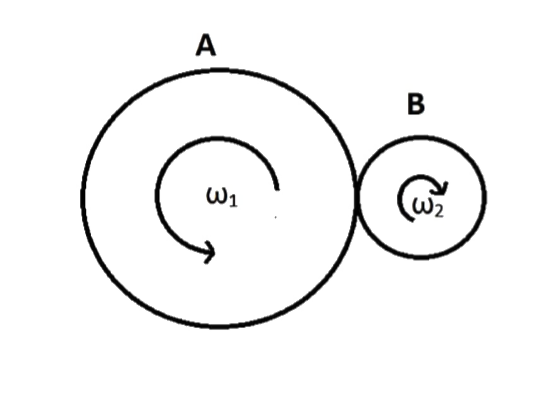Two radio stations broadcast their programmes at the same amplitude A, and at slightly different frequencies ω1andω2 respectively , where ω2−ω1=103Hz. A detector receives the signals from the two stations simultaneously . It can emit signals only of intensity ≥2A2.
(i). Find the time intervals between successive maxima of the intensity of the signal received by the detector .
ii. Find the time for which the detector remains idle in each cycle of the intensity of the signal .
To solve the problem step by step, we will break it down into two parts as per the question.
Part (i): Finding the time intervals between successive maxima of the intensity of the signal received by the detector.
1. Understanding the Signals:
- The two signals from the radio stations can be represented as:
y1=Asin(ω1t)andy2=Asin(ω2t)
- The resultant signal yr is given by the superposition of these two signals:
yr=y1+y2
2. Using the Trigonometric Identity:
- We can use the identity for the sum of sines:
yr=2Acos(ω2−ω12t)sin(ω1+ω22t)
- Here, ω2−ω1=1000Hz implies:
ω2−ω12=500Hz
3. Finding the Time for Maxima:
- The intensity I is maximum when cos(ω2−ω12t)=1.
- This occurs when:
1000π2t=nπ(n=0,1,2,…)
- Simplifying gives:
1000πt=nπ⟹t=n1000seconds
4. Finding the Time Interval Between Successive Maxima:
- The time interval between successive maxima is:
Δt=11000seconds=1millisecond
Part (ii): Finding the time for which the detector remains idle in each cycle of the intensity of the signal.
1. Understanding the Intensity:
- The intensity I can be expressed as:
I=A21+A22+2A1A2cos(Δϕ)
- Given A1=A and A2=A, we have:
I=A2+A2+2A2cos(Δϕ)=2A2(1+cos(Δϕ))
2. Finding the Maximum and Minimum Intensity:
- The maximum intensity occurs when cos(Δϕ)=1:
Imax=4A2
- The minimum intensity occurs when cos(Δϕ)=−1:
Imin=0
3. Finding the Idle Time:
- The detector emits signals only when I≥2A2.
- This condition is satisfied when cos(Δϕ)≥0, which occurs for half of the cycle of the cosine function (from 0 to π).
- The time period of the signal is T=1Δf=11000seconds=1millisecond.
- Therefore, the idle time is:
Idle Time=T2=1millisecond2=0.5milliseconds=500μs
Final Answers:
1. The time intervals between successive maxima of the intensity of the signal received by the detector is 1 millisecond.
2. The time for which the detector remains idle in each cycle of the intensity of the signal is 0.5 milliseconds.
- The two signals from the radio stations can be represented as:
y1=Asin(ω1t)andy2=Asin(ω2t)
- The resultant signal yr is given by the superposition of these two signals:
yr=y1+y2
- We can use the identity for the sum of sines:
yr=2Acos(ω2−ω12t)sin(ω1+ω22t)
- Here, ω2−ω1=1000Hz implies:
ω2−ω12=500Hz
- The intensity I is maximum when cos(ω2−ω12t)=1.
- This occurs when:
1000π2t=nπ(n=0,1,2,…)
- Simplifying gives:
1000πt=nπ⟹t=n1000seconds
- The time interval between successive maxima is:
Δt=11000seconds=1millisecond
- The intensity I can be expressed as:
I=A21+A22+2A1A2cos(Δϕ)
- Given A1=A and A2=A, we have:
I=A2+A2+2A2cos(Δϕ)=2A2(1+cos(Δϕ))
- The maximum intensity occurs when cos(Δϕ)=1:
Imax=4A2
- The minimum intensity occurs when cos(Δϕ)=−1:
Imin=0
- The detector emits signals only when I≥2A2.
- This condition is satisfied when cos(Δϕ)≥0, which occurs for half of the cycle of the cosine function (from 0 to π).
- The time period of the signal is T=1Δf=11000seconds=1millisecond.
- Therefore, the idle time is:
Idle Time=T2=1millisecond2=0.5milliseconds=500μs
1. The time intervals between successive maxima of the intensity of the signal received by the detector is 1 millisecond.
2. The time for which the detector remains idle in each cycle of the intensity of the signal is 0.5 milliseconds.
Similar Questions
Two radio stations broadcast their programmes at the same amplitude A and at slightly different frequencies ω1 and ω2 respectively, where ω1−ω2=103Hz. A detector receives the signals from the two stations simultaneously, it can only detect signals of intensity ≥2A2.
(i) Find the time interval between successive maxima of the intensity of the signal received by the detector.
(ii) Find the time for which the detector remains idle in each cycle of the intensity of the signal.
View SolutionWhen two waves of almost equal frequencies n1 andn2 reach at a point simultaneously, what is the time interval between successive maxima ?
View Solution
Knowledge Check
When two waves of almost equal frequencies v1 and v2 reach at a point simultaneously, the time interval between successive maxima is
Aυ1+υ2Bυ1−υ2C1υ1+υ2D1υ1−υ2
Find the amplitude of the electric field in a parallel bean of light of intensity 2.0Wm−2.
View SolutionThe planes sources of sound of frequency n1=400Hz,n2=401Hz of equal amplitude of a each, are sounded together. A detector receives waves from the two sources simultaneously. It can detect signals of amplitude with magnitude ≥ a only,
View SolutionTwo waves of frequency 500 Hz and 498 Hz are produced simultaneously. Calculate the time interval between successive maxima.
View SolutionTwo waves of frequencies 50 Hz and 45 Hz are produced simultaneously, then the time interval between successive maxima of the resulting wave is [maxima refers to the maximum intensity]
View SolutionTwo lenses have focal lengths f1 and f2 and their dispersive powers are ω1 and ω2 respectively. They will together form an achromatic combination if
View SolutionTwo discs A and B are in contact and rotating with angular velocity with angular velocities ω1andω2 respectively as shown. If there is no slipping between the discs, then

View SolutionWhen two progressive waves of intensity I1 and I2 but slightly different frequencies superpose, the resultant intensity flutuates between :-
View Solution
